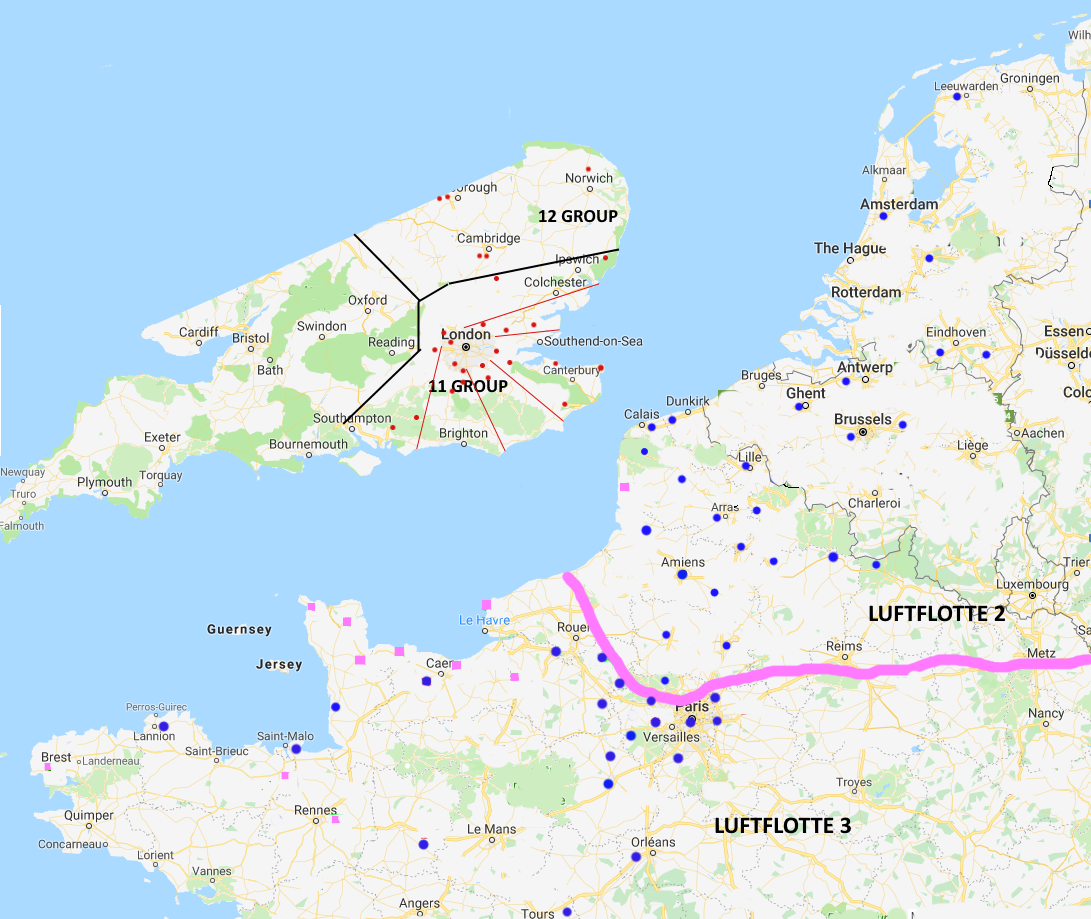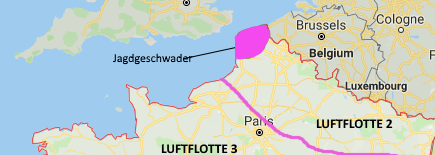
The Luftwaffe:
Under the Treaty of Versailles Germany was not permitted an air force.
Nevertheless, the Luftwaffe was developed in secret under the direction of Erhard
Milch and Herman Göring . This incorporated the glider clubs of the NSFK
(Nationalsozialist Flieger Korps), while pilot and navigational instruction
was conducted by Lufthansa on a rotation scheme. The existence of the Luftwaffe
was made official in early 1935 with the tacit and helpless acknowledgement
of the Allies. The application by Germany to glider design and aerodynamics
in this period led to the development of aircraft that were significantly superior
to those of the allied powers. It was their later deployment in inappropriate
roles that limited their use.
For the developing Luftwaffe, as with the RAF, the emphasis in aircraft development was for bombers, but in this case all were designed with a dive-bomber capability. Ground attack aircraft took precedence over fighters. Indeed, the whole concept of the Luftwaffe was that of a tactical air force in support of ground forces. There was little interest in the design of four-engined bombers. Range and carrying capacity were sacrificed in favour of speed and maneuverability.
This specifically designed role was ideal for the Blitzkrieg concept and rapid successes in continental Europe were due to the close cooperation between infantry, armour and air commands. However, when the Luftwaffe was given the task of defeating the RAF in the air and on the ground, it was faced with a series of strategic problems for which it was neither trained, equipped or prepared.
Luftwaffe Tactics:
The problems faced by the Luftwaffe were equally acute. Fighter
aircraft did not have the range necessary to provide adequate escort. Nor was
there any cohesive plan as to how bombers could best be escorted. Indeed, there
were no stated objectives or priorities at all for the whole operation. The
bombing force had the range but not the carrying capacity to inflict lasting
damage on selected targets and follow-up operations were randomly assigned. The
vulnerability of bombers resulted in a variety of changing tactics by the Commander of Luftflott 2, Albert Kesselring.
Bf109s were given free rein to patrol the south coast (freijagd), provoking
RAF fighters to intercept. Park however, was uncompromising and the Jagdgeschwader sorties were largely ignored. Göring, dismayed at the continuing bomber
losses, demanded larger and yet closer fighter escorts on a ratio of three fighters
to each bomber, a total waste of resources. Later, more and more Bf109s were
taken from Luftflotte 3 to strengthen Luftflotte 2 while the medium bombers
were gradually withdrawn from daylight operations. Jabo (Jagdbomber) units,
(Bf109s modified to carry a single 250Kg bomb), were formed and included in the
freijagd tactics forcing fighter Command to commit aircraft to intercept. This
last tactic was highly successful and, if pursued, could have changed the outcome
of the battle.
Two major factors that would affect the course of the battle were that Luftwaffe aircraft shot down over Britain, in the North Sea or in the Channel were a total loss, with the consequent loss of trained aircrew. Conversely, for the RAF there was a significant recovery rate of both pilots and aircraft who could, and would, return to fight again. The second factor was that for the first time the Luftwaffe would be meeting an opposing force of almost equal technical advancement that was linked to an effective interception system. This was never fully realised by the Luftwaffe who disregarded the radio towers as a serious threat, largely due to poor intelligencce.
The lack of reliable intelligence also contributed to a lack of target priorities. It was a source of constant frustration to the Jagdgeschwader pilots that they were were given no indication as to whether they were expected to use the bomber formations as a means of drawing the RAF fighters into the escorts or for the bombers to destroy the RAF on the ground by bombing attacks. This indecision wasted both aircraft and crew at a time when the Kampfgeschwader (Bomb Groups) could not afford to take such losses.
Eagle Attack:
'Adlerangriffe'
Göring planned what he considered
to be a knockout blow starting on 13 August. Adlerangriff (Eagle Attack).
It was a failure. Most of the force was recalled but some Gruppen did not
receive the signal and continued to meet strong opposition without fighter escorts.
Again, there were no target priorities and the poor weather made an already
confused situation worse. Later in the day, when the weather had improved, military
targets were specified, particularly fighter airfields, but the Luftwaffe could
not distinguish between fighter and bomber fields. By the end of the day the
losses on both side were approximately equal. But, most important, the Luftwaffe
had failed to subdue Fighter Command.
On 15 August another massive attack was
attempted, this time coordinated with Luftflotte 5, so that RAF forces were
split. Again, confused orders and misunderstandings blunted the attack. The
attacks in August became as regular as they were ferocious. RAF Fighter Command
was now desperately short of pilots and the existing crews were exhausted. In
the last week of August, 11 Group airfields were targeted and Fighter Command
was now in serious trouble. At this rate there would be little to put into the
air and even less to land on within two weeks. The RAF was now on the edge of
defeat.
Changing targets:
Then, starting on 7 September, Hitler ordered a massive raid on London in response to a raid by Bomber Command on Berlin on 25th/26th August which, despite the paucity of damage, had infuriated him and embarrased Göring, both of whom had said it could never happen. The London docklands in particular were badly damaged as were many suburban areas in the east of London. The raids were repeated over the next two days causing massive damage but with the consequent heavy losses to the bomber force. A further heavy raid on London was carried out on the 10th of September while Bomber Command again attacked Berlin that night, this time causing significant damage. The RAF bombers were also conducting successful daily raids on the assembly points, rail junctions and storage facilities in northern France and Belgium.
A further Luftwaffe raid was planned for September 15th
but Göring's coded actioning order to Kesselring and Sperrle was intercepted by Ultra based at Bletchley Park. The RAF units were prepared and waiting. Every fighter squadron was in the air or on standby. As the day progressed, with fighters landing only to refuel and re-arm before returning to the battle over London, the bomber force was torn to shreds. It was a miracle for the
RAF and a massive blunder by the Luftwaffe who never knew how close they had
come to victory had they not changed targets.
Luftwaffe Order of Battle (ORBAT) 1940
Bombers, (Kampfgeschwader), Heavy fighters, (Zerstörergeschwader) and dive bombers, (Stukageschwader), are represented by blue circles. Day fighters, (Jagdgeschwader), are shown as pink rectangles. As these last were concentrated in a very small area of Luftflotte 2 around the Pas de Calais, a separate map below shows their dispositions.
On mouseover the location, unit and operational aircraft are shown for Luftwaffe deployments but not for those of the RAF where the frequent rotation of squadrons gave an ever-changing picture of the forces present.
Only the most southerly RAF stations of 12 Group are shown as those located further North, Tern Hill, Digby, Church Fenton, Leconfield, and Kirton-on-Lindsey were effectively out of range of the battle to their South.

|
 |
|